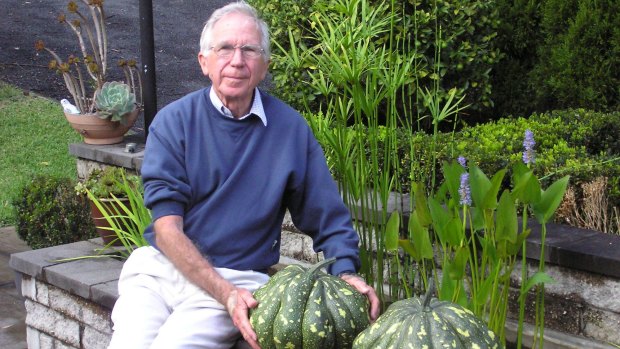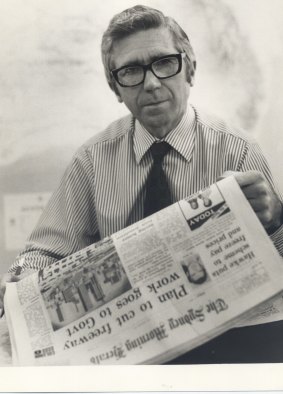ALAN DOBBYN 1929–2015
Alan Dobbyn's career as a newspaper journalist encompassed some, though not all, of the golden age of journalism, when newspapers were the primary source of news and the metropolitan morning newspaper hitting the streets each morning set the agenda for the day.

Alan Dobbyn with his pumpkins, in retirement in 2007.
The Sydney Morning Herald, to which Dobbyn gave 34 years of his life, was at the beginning like a great ship sailing untroubled into the future, prosperous, seemingly unchallengeable, staid, conservative and gentlemanly.
Dobbyn, who started as a teenage proof-reader on a regional newspaper, epitomised this. During his service from 1954 till 1988, he was news editor and bureau chief for John Fairfax and Sons Ltd in both New York and London. He was dedicated, reflective and tough, and moderated everything with a quiet sense of humour.

Alan Dobbyn as news editor.
Those qualities in Dobbyn were exemplified by his actions when NASA's Skylab crashed to earth in 1979. It was due to come down, and as former Herald reporter Ben Sandilands wrote in Crikey in 2011, Murdoch's Daily Telegraph decided near enough was good enough. It put out a final edition quoting unnamed witnesses at an unnamed location describing Skylab crashing in a ball of flame. The spacecraft was still in orbit. "The only other person in the newsroom was Alan Dobbyn, the editor," Sandilands wrote. The two of them decided to stay, and were there when Skylab made its final pass over Western Australia and broke up.
"Alan did the layout changes, wrote a street poster, and told me the number of paragraphs needed for the page one remake to fit in the interviews of eyewitnesses," said Sandilands. "We did a special edition, a 60,000 copy print run, that hit the streets before 6 am: 'Skylab crashes in WA'. The real story. Our story alone."
Alan Ronald Dobbyn was born at Mildura in north-western Victoria on December 18, 1929, youngest of four children of Harry Dobbyn, a piano repairer and music-shop owner, and Mabel (nee Hill). From an early age he loved to write. He made up little newspapers about family events for family circulation. He was 11 when his mother died, a loss he felt keenly. Alan attended Mildura High and sat for his leaving certificate in 1944, at 15.
He returned to school to get his matriculation but opted to take up a job at the local newspaper, the Sunraysia Daily. His first job was as assistant proof-reader. He then got a cadetship as a journalist. Though journalism was to take him into the international sphere, he never quite lost the traces of his bush origins and was proud of them. His speech in later life was to be littered with somewhat archaic country expressions. Raw copy coming to the sub-editor's table was "as rough as goats' knees" and a corrupt official was as "crooked as a dog's hind leg".
In the meantime, Dobbyn as a junior reporter learnt the nuts and bolts of his trade, attending court cases, covering funerals and writing local theatre reviews. Those working in the regional media anywhere can always expect the big story to drop into their lap. In 1948 the Indian cricket team was visiting Mildura when Gandhi was assassinated. Dobbyn was obliged to go to the hotel and break the news to them. "Their shock was profound. I felt embarrassed to be watching," he wrote for the Sunraysia Daily's centennial edition in 1988.
Dobbyn moved to Sydney in 1951 to join the staff of the Sydney Daily Mirror. He had a number of assignments to other cities as a subeditor and he was working in Brisbane for the Brisbane Truth when he met a book-keeper, Daphne Wendt, daughter of a builder, Harry Wendt, in the Brisbane suburb of Greenslopes. Dobbyn joined The Sydney Morning Herald in January, 1954, and married Daphne in 1956.
In 1964, Dobbyn was appointed Fairfax bureau chief to New York, where he presided over a talented group of writers, including Lillian Roxon, author of the first encyclopaedia of rock music, and Margaret Jones, one of the first western correspondents to be allowed into Communist China.
Returning in 1966, Dobbyn entered an Australian newspaper world which was starting to undergo massive and permanent change. Challenged by television and radio, newspapers had to adapt, one way being to publish food and entertainment supplements. Fairfax was also locked in a circulation war between the Fairfax and Murdoch stables. "Alan was always fair and equitable but certainly not soft," said former Herald journalist Jason Dasey. And he had passion. He advised his children who might have followed him into journalism: "Never work for Murdoch!"
Dobbyn did not lack a fierce competitive streak. Needing a good front-page picture for a Monday morning edition, he had no hesitation in using a photograph of a man standing waist-deep in water beside his employer-issued car, also partially immersed, following a botched boat-ramp manoeuvre. The man happened to be a personal friend and the item in the paper did not go down well.
Dobbyn also had a generous side. In the late 1950s, at the urgings of his wife, he had persuaded fellow subeditors to kick in a few shillings each week to assist in the education of Aboriginal children. One of these was Mervyn Bishop, a boy from Brewarrina who attended Dubbo High School. Bishop had inclinations to write but Dobbyn, aware of Bishop's interest in photography, urged him to apply for a cadetship as a photographer at the Herald. Bishop went on to achieve great things, including a 1975 photo of Prime Minister Gough Whitlam pouring soil into the hands of Vincent Lingiari as a sign of the return of the land to the Guringji people in the Northern Territory.
Dobbyn became news editor in 1973 and held the job for a record seven years. He was at all times an assuring and steadying presence, and mentored many young journalists who went on to do well. After suffering some serious health problems, he helped organise the sesquicentenary celebrations of The Sydney Morning Herald in 1981. He then spent seven years managing the Fairfax London office, a posting extended by the Fairfax acquisition of UK publishing interests, including the Spectator magazine.
In 1987, the takeover of Fairfax in a leveraged buyout by Warwick Fairfax swelled the assets of the company pension fund, and Dobbyn and a number of his colleagues opted to retire. He and Daphne returned to Australia in 1988. In 1997, the couple moved to Stroud, north of Newcastle, settled on a hill overlooking the town and threw themselves into helping to preserve the unique collection of Georgian buildings in the town, a legacy of the first venture by the Australian Agricultural Company, including St John's Anglican Church, built in 1833 as the company's chapel. Dobbyn's legacy includes the Stroud Heritage Conservation Trust, which helps fund the restoration of these structures under the patronage of Professor The Hon. Dame Marie Bashir AC CVO and Mr John B. Fairfax AO.
Alan Dobbyn is survived by Daphne, children Tim, who followed him into journalism and worked for Reuters in the United States, Luke, who pursued a banking career, Anna, who became a doctor, his brother, William, and six grandchildren.
The funeral will be at St Peter's Anglican Church, Cremorne, on Tuesday, April 21, at 11.30 am, followed by a wake.
Malcolm Brown and Tim Dobbyn